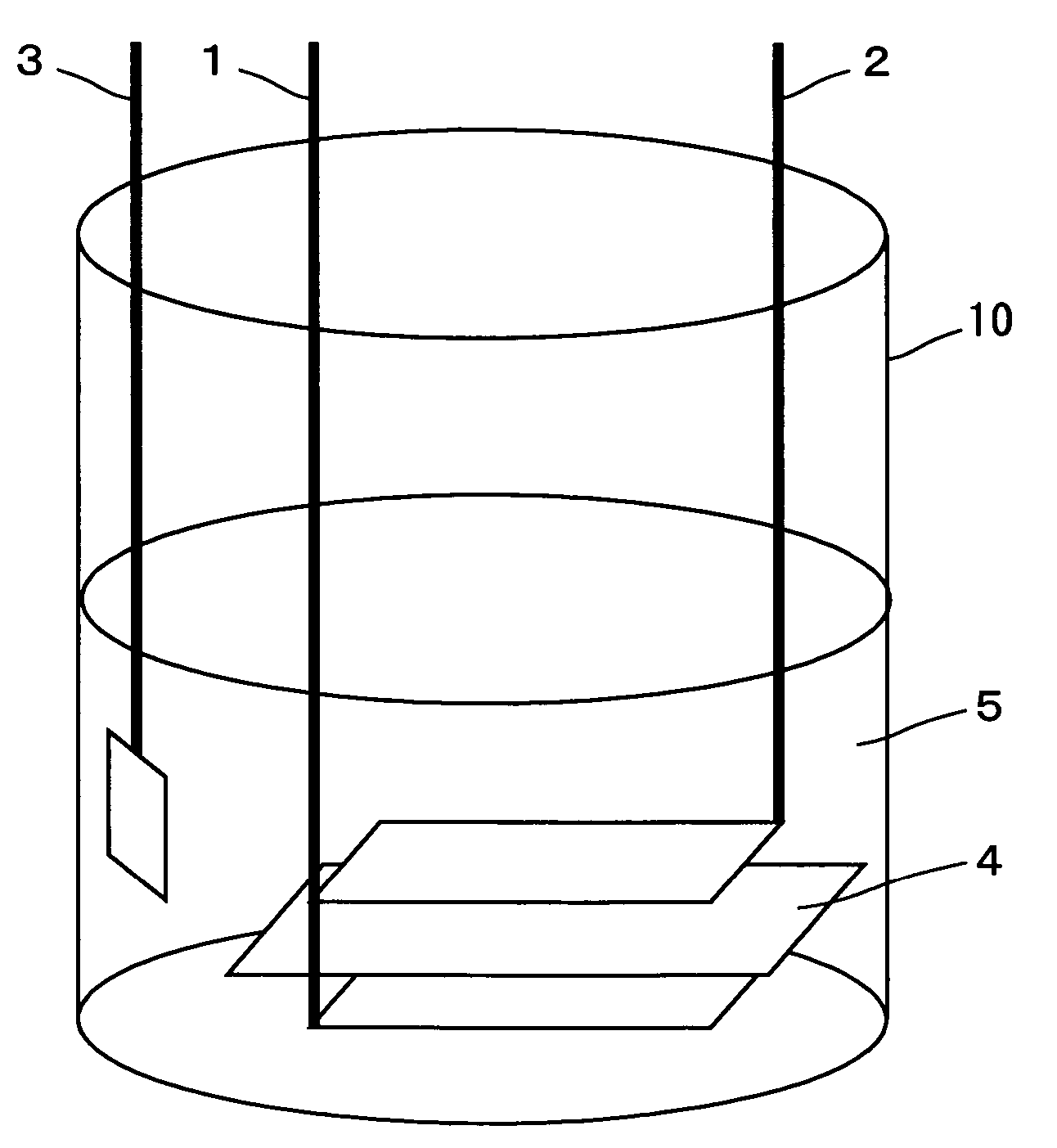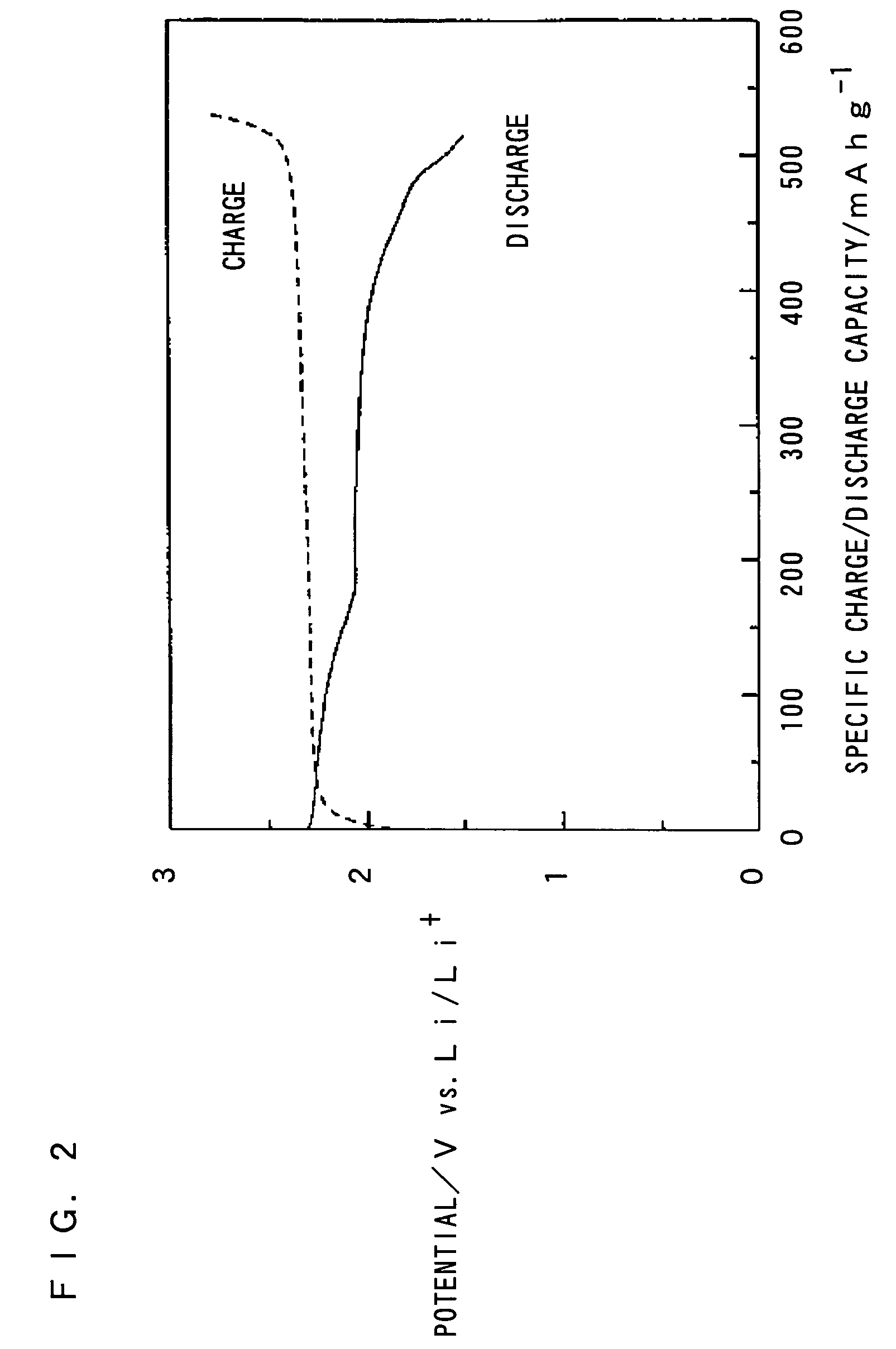Nonaqueous electrolyte secondary battery
a secondary battery and electrolyte technology, applied in the direction of non-aqueous electrolyte cells, cell components, electrochemical generators, etc., to achieve good cycle performance and charge/discharge efficiency, increase capacity and energy density, and improve the effect of energy density
- Summary
- Abstract
- Description
- Claims
- Application Information
AI Technical Summary
Benefits of technology
Problems solved by technology
Method used
Image
Examples
##ventive example 1
Inventive Example 1
[0081] A nonaqueous electrolyte according to the inventive example 1 was prepared as follows. 4-methyl-1,3-dioxolane and trimethylpropylammoniumbis(trifluoromethylsulfonyl)imide, a room temperature molten salt, were mixed in a volume ratio of 10:90. To the resultant mixture was added lithium sulfide to give a concentration of 0.5 mol / l, and elemental sulfur to give a concentration of 3.5 mol / l. Then, using hot water of 60° C., the dissolution of the lithium sulfur and elemental sulfur in the resultant solution was promoted to produce polysulfide. The polysulfide saturated was employed as the nonaqueous electrolyte. The nonaqueous electrolyte exhibited an auburn color, which is probably attributed to the polysulfide production.
[0082] The positive electrode was prepared as follows. Elemental sulfur as an active material was adjusted to be 60 wt % for the whole positive electrode, and Ketchen black as a conductive agent was adjusted to be 35 wt % for the whole posit...
##ventive example 2
Inventive Example 2
[0089] A nonaqueous electrolyte according to the inventive example 2 was prepared as follows. 4-methyl-1,3-dioxolane and trimethylpropylammoniumbis(trifluoromethylsulfonyl)imide, a room temperature molten salt, were mixed in a volume ratio of 20:80. To the resultant mixture was added lithium sulfide to give a concentration of 0.5 mol / l, and elemental sulfur to give a concentration of 3.5 mol / l. Then, using hot water of 60° C., the dissolution of the lithium sulfur and elemental sulfur in the resultant solution was promoted to produce polysulfide. The polysulfide saturated was employed as the nonaqueous electrolyte. Otherwise, the test cell of the inventive example 2 was prepared similarly as in the inventive example 1.
[0090] The test cell of the inventive example 2 was discharged to a discharge cutoff potential of 1.5V (vs. Li / Li+) at a discharge current of 0.05 mA / cm2, and charged to a charge cutoff potential of 2.8 V (vs. Li / Li+) at a charge current of 0.05 mA / ...
##ventive example 3
Inventive Example 3
[0095] A nonaqueous electrolyte according to the inventive example 3 was prepared as follows. 4-methyl-1,3-dioxolane and trimethylpropylammoniumbis(trifluoromethylsulfonyl)imide, a room temperature molten salt, were mixed in a volume ratio of 30:70. To the resultant mixture was added lithium sulfide to give a concentration of 0.5 mol / l, and elemental sulfur to give a concentration of 3.5 mol / l. Then, using hot water of 60° C., the dissolution of the lithium sulfur and elemental sulfur in the resultant solution was promoted to produce polysulfide. The polysulfide saturated was employed as the nonaqueous electrolyte. Otherwise, the test cell of the inventive example 3 was prepared similarly as in the inventive example 1.
[0096] The test cell of the inventive example 3 was discharged to a discharge cutoff potential of 1.5V (vs. Li / Li+) at a discharge current of 0.05 mA / cm2, and charged to a charge cutoff potential of 2.8 V (vs. Li / Li+) at a charge current of 0.05 mA / ...
PUM
| Property | Measurement | Unit |
|---|---|---|
| melting point | aaaaa | aaaaa |
| melting points | aaaaa | aaaaa |
| temperature | aaaaa | aaaaa |
Abstract
Description
Claims
Application Information
 Login to View More
Login to View More - R&D
- Intellectual Property
- Life Sciences
- Materials
- Tech Scout
- Unparalleled Data Quality
- Higher Quality Content
- 60% Fewer Hallucinations
Browse by: Latest US Patents, China's latest patents, Technical Efficacy Thesaurus, Application Domain, Technology Topic, Popular Technical Reports.
© 2025 PatSnap. All rights reserved.Legal|Privacy policy|Modern Slavery Act Transparency Statement|Sitemap|About US| Contact US: help@patsnap.com



